1 Beijing: Home of the Imperial Palace and Forbidden City
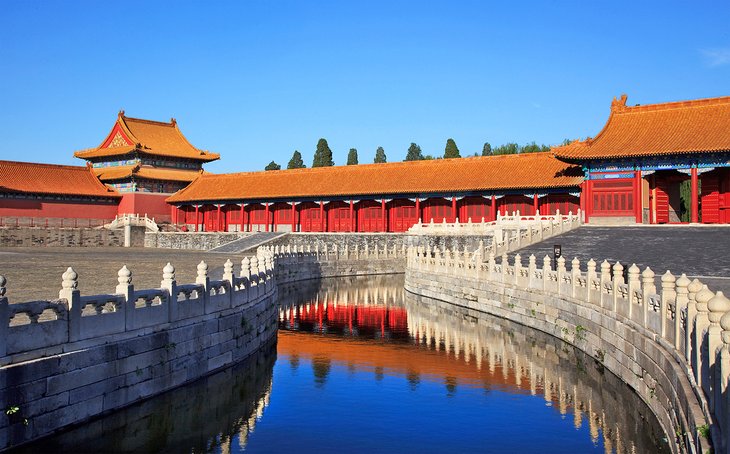
Beijing: Home of the Imperial Palace and Forbidden City
China's second biggest city, Beijing has been the country's political center for more than 800 years, and for almost as long, it has been an important center for cultural, economic, scientific, and academic life. Still often referred to as Peking, Beijing is home to many of China's best-known attractions, including the spectacular Imperial Palace, also known as the Forbidden City. Many of the city's attractions are in its well-preserved historic city center, making it possible to visit most of them on foot. Of these, highlights include the magnificent Heavenly Temple; Tian'anmen Square, the world's largest public square; beautiful Beihai Park; and the fascinating Beijing Ancient Observatory, built in 1442 and still in use in the early 20th century. Beijing is also a great place from which to explore the surrounding area and attractions such as the Great Wall.
2 Historic Xi'an: The Terracotta Army and More
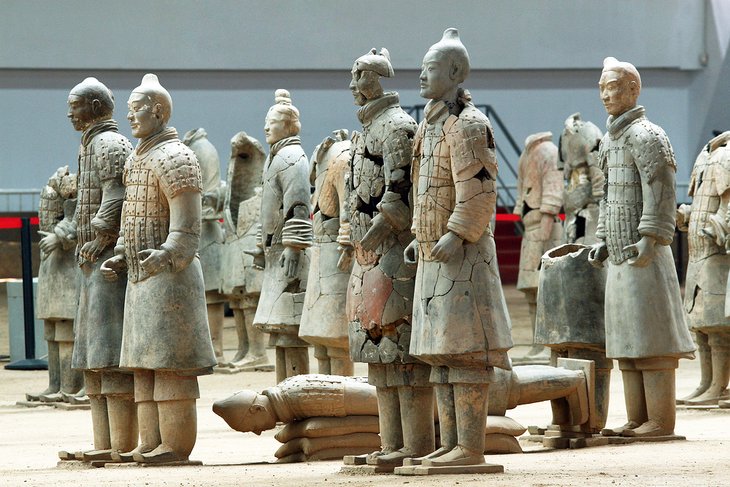
Historic Xi'an: The Terracotta Army and More
Xi'an, between the Weihe River in the north and the Qinling Mountains in the south, is one of Northwest China's chief textile centers and possesses more items of archaeological interest than perhaps any other smaller city in China, the most important being the world-famous Terracotta Army. Xi'an's history stretches back some 6,000 years, and by the 3rd century BC, it boasted one of the highest urban populations in China. The remains of the Han imperial residence can still be seen, along with evidence of the city's importance as the starting point of the famous Silk Road, which from here wound its way through Central Asia and the Middle East as far as the Mediterranean, linking Xi'an with such far away cities as Istanbul and Venice. Among Xi'an's other important historic sites are the 64-meter-tall Pagoda of the Great Wild Goose, a survivor of the Tang Dynasty from 618-907 AD, and the 43-meter-high Pagoda of the Small Wild Goose, built in 684 AD in honor of the Tang Emperor Gaozong. Other must-sees include the Historical Museum of Shaanxi Province, China's most important archaeological museum, illustrating the origins and achievements of Chinese culture from prehistory to the Qing period of 1368 to 1911; the Town Walls, completed in 1398 with four gates and numerous watchtowers; and the city's 15th-century mosque with its five courtyards and traditional Chinese buildings decorated with Islamic patterns.
3 Shanghai
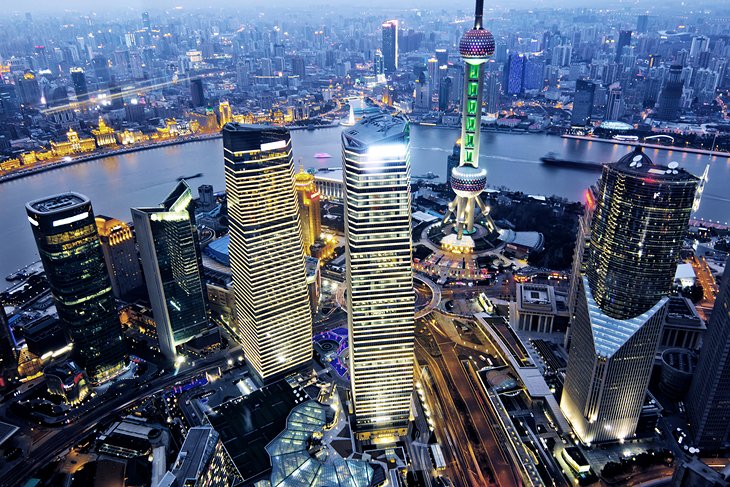
Shanghai
The largest city in China, Shanghai is also perhaps its most modern and offers a diversity of tourist attractions both old and new. Boasting in excess of 24 million citizens, the city's highlights include numerous world-class museums and art galleries, ranging from the excellent Shanghai Museum to the China Art Museum, along with a surprising number of quiet green spaces, old temples, and pagodas. Must-sees include Shanghai's broad promenade, the Bund, which runs along the west bank of the Huangpujiang River and is popular for its very distinctive European architecture, and the beautiful Yu Garden (the Garden of Happiness) with its many fine old buildings. More modern attractions include the 468-meter-tall Oriental Pearl Radio and TV Tower with its excellent views over the river and city, and the fun Shanghai Science and Technology Museum, one of the country's most visited science museums.
4 Hangzhou and the Historic Grand Canal

Hangzhou and the Historic Grand Canal
At the southern end of China's famous 1,776-kilometer-long Grand Canal, a remarkable engineering feat and UNESCO World Heritage site, Hangzhou is one of China's most visited cities. As big a draw as this centuries-old canal that connects Hangzhou to Beijing is the city's picturesque location at the foot of a tall mountain range by beautiful West Lake with its many old shrines and temples, romantic bridges, and pleasant pagodas. Still often called the Silk City for its many silk mills and markets, Hangzhou has attracted many of China's most important artists through the centuries, as well as famous travelers such as Marco Polo, who declared it the most beautiful city in the world. A tradition that has been around even longer than the legend of Marco Polo is taking the famous Dragon Well tea (lóngjǐng chá), handpicked in the surrounding countryside twice a year and still much celebrated in art and ceremonies throughout the city.
5 Qufu and Confucius

Entrance Gate at Confucius Grave Site
Thanks to its connections with Confucius, China's most revered philosopher, the small town of Qufu in southwest Shandong has long been one of the country's most important places of pilgrimage. Not only was Confucius born here in 551 BC, he was also buried here in 479 BC. As a result, numerous temples and shrines have been erected by devotees in celebration of his life and teachings. Perhaps the most important of the three main historic sites related to the great teacher - together part of a UNESCO World Heritage Site - is the Cemetery of Confucius (Kong Lin), a large burial ground containing the graves of Confucius, family members, and numerous followers. The grave itself is a mound marked by a 15th-century gravestone carrying the inscription "Grave of the Sacred King of Culture, who achieved Absolute Perfection," while nearby are the graves of his son and grandson. The cemetery, laid out around Confucius' grave in the 14th century, makes for a delightful excursion thanks to its more than 10,000 trees. Other important sites worth exploring are the Temple of Confucius and the Kong Family Mansion.
6 Chengdu's Pandas
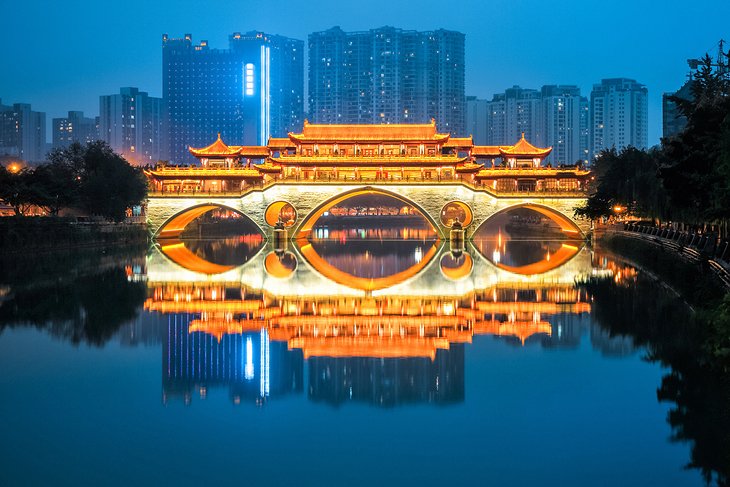
Anshun Bridge in Chengdu
If when you think of China, you think of pandas, you'll want to make sure the city of Chengdu is on your list of must-sees. It's here you'll find the Chengdu Research Base of Giant Panda Breeding, a massive facility that is home to more than 80 of these wonderful animals. Tours of the facility include a chance to see pandas up close (try to time your visit to coincide with feeding time) as well as an on-site museum featuring exhibits detailing everything you'll ever want to know about the challenges of conserving these notoriously placid creatures. For a chance to see pandas in the wild, head to the Wolong Nature Reserve, two hours west of Chengdu, a vast scenic area that serves to protect the natural habitat of pandas and other important species. Other Chengdu attractions worth seeing include numerous old pagodas and bridges, as well as religious sites such as the Monastery of Precious Light and Chengdu Huangcheng Mosque, one of China's oldest and most important Muslim sites.
7 The City of Ceramics: Zibo
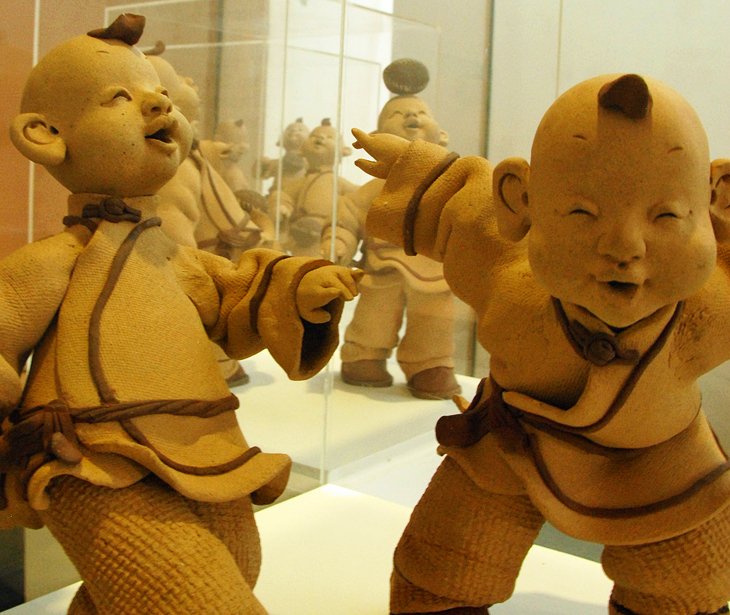
The City of Ceramics: Zibo
In the center of Shandong province, the city of Zibo was the capital of the Qi Empire for 630 years, during which time it became famous for its ceramics and lacquered works of art (it was here that China's famous green glass was first developed some 1,500 years ago, as well as the region's distinctive black glazed porcelain). Between 960 and 1279, local makers also perfected the technique of coating earthenware with a brownish layer of glaze displaying tear-shaped runs, a still popular style that has cemented Zibo's reputation for hand-made porcelain and ensured its status as China's major producer of ceramics. Zibo's connection to the history of ceramics is celebrated at the Zibo Chinese Ceramics Center with its large collections of locally produced artifacts and displays showing both modern and traditional manufacturing methods. Another attraction worth seeing is the Great Wall of the Qi, more than 2,500 years old and with many sections of its 600-kilometer-length still standing. Zibo boasts a variety of other interesting cultural experiences, including its unique cuisine and theatrical performances, which can be included as part of a tour package.
8 Ningbo and the Tianyi Ge Library
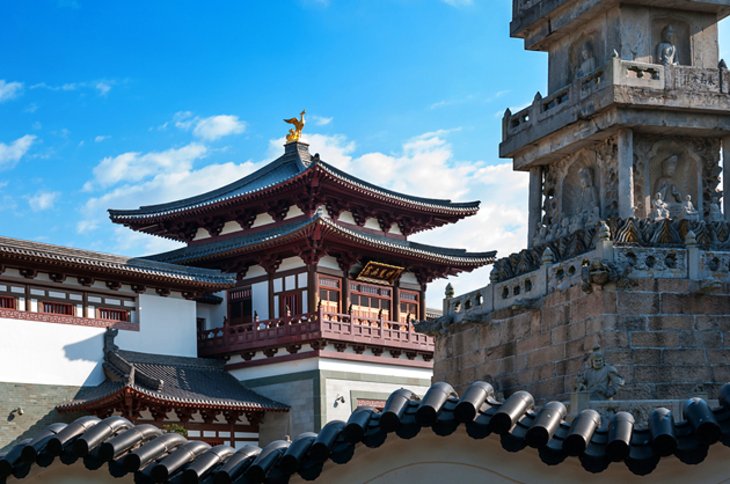
Ningbo and the Tianyi Ge Library
Ningbo, in the northeast corner of the province of Zhejiang, just 25 kilometers from the East China Sea, has been one of the country's most important ports since the 7th century. Crisscrossed by countless navigable canals, this busy city - dubbed Little Shanghai - can trace its history back some 2,300 years to the period of the Qin Dynasty and includes such historic sites as the magnificent Tianyi Ge Library, built by high-ranking official Fan Qing between 1561 and 1566 to house his private book collection, one of the oldest of its kind in China. Consisting of some 80,000 rare Chinese volumes and manuscripts, this remarkably preserved collection also includes a large number of stone inscriptions dating from the 14th century (also of interest is the artificial pond outside this splendid old two-story structure, intended to provide water in the event of a fire). Also of interest is the 55-meter-tall, seven-story Tianfeng Ta Pagoda - also known as the Tang Pagoda - built in 695 AD and well worth the climb for its panoramic views of the old city.
9 Quanzhou's International Influences
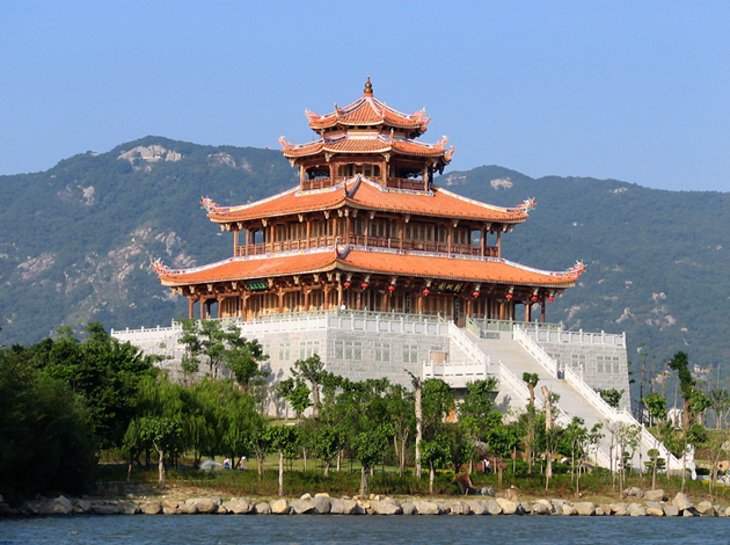
Quanzhou's International Influences
In the southeast corner of the Fujian province on the broad Jinjiang estuary, Quanzhou was already an important port in the 6th century. Highlights of this historic port include the Temple of the Beginning of the New Age, built in 686 AD and one of the largest temples in China. Covering some 70,000 square meters, this temple site includes a number of impressive pagodas: the 48-meter-tall eastern pagoda (Zhenguo) dating from the end of the Tang Dynasty around 700 AD and decorated with 39 bas-reliefs crafted from alabaster, and the 44-meter Pagoda of Longevity (Renshou Ta) from the early 10th century and decorated with birds and flowers. Also of interest is the Mosque of Peace and Clarity, erected in 1009 in the style of a Damascus prayer house and financed by Muslim merchants. One of the oldest mosques in China, the building is noted for its impressive main gate and walls with Arabic engravings of the Koran. Be sure to also visit the Quanzhou Maritime Museum with its historic displays including a 24-meter-long 10th-century sailing ship; hundreds of sculptures; and stone tablets with inscriptions in old Chinese, Latin, Syrian, and Arabic, along with numerous ceramic pieces crafted in Quanzhou from the 10th century onwards.
10 Yangzhou
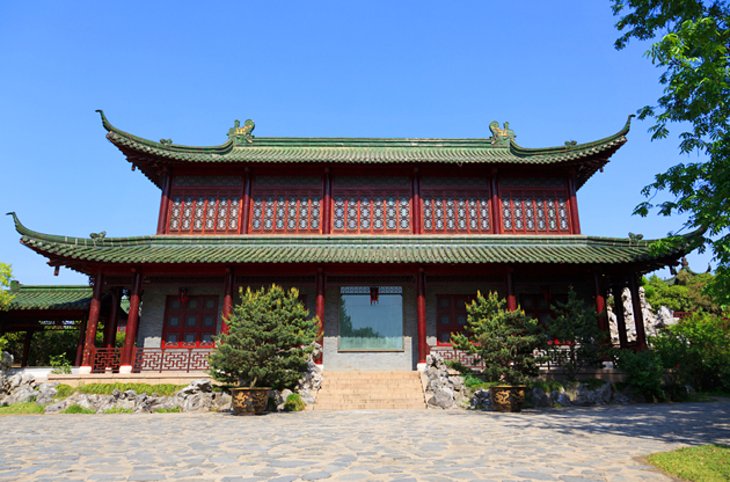
Yangzhou
Yangzhou lies in the central region of Jiangsu province between the Yangtze River and the Grand Canal and can trace its roots back some 2,400 years. It was the building of the canal in the 6th century, however, that saw the city rise in importance as a place of foreign trade, attracting the likes of Arab missionary Behao Aldin in the 7th century and Marco Polo, who stayed here for a spell. In addition to being famous for its traditional local cuisine, eccentric art forms, and handicrafts, the town boasts a number of first-rate attractions that together form a great walking tour of the old town, among them the picturesque Narrow West Lake, the old Bridge of the Great Rainbow(Dahong Qiao), the 18th-century Bridge of the Five Pavilions, and Fuzhuang Island, reached by a zig-zag bridge and home to a number of pleasant pavilions and covered walks. Must-see attractions include the 4th-century Temple of Heavenly Peace at the foot of the Mountain of the Plum Blossom (Meihua Ling) and famous as the place where, in 418 AD, a Nepalese monk translated the Buddhist scriptures, and the 1,500-year-old Daming Temple, once home to the monk Jianzhen, famous for spreading the Buddhist gospel to Japan.
11 The Gardens of Wuhan

The Gardens of Wuhan
Large by Western standards due to its population of nearly three-and-a-half million souls, Wuhan, the capital of Hebei Province, lies at the confluence of the Yangtze and Hanshui rivers on the Beijing-Canton rail route in Central China. Well over 3,000 years old, the city offers a number of first-rate tourist attractions worth exploring on foot. One of the best is East Lake, the largest urban lake in China and famous for its many gardens that burst forth each spring in a cacophony of color as cherry trees and lotus flowers bloom. Those with an interest in Chinese culture and history are well served, too, thanks to the excellent Hubei Provincial Museum. Highlights of the museum, regarded as one of the best in China, include rare finds from the 5th-century tomb of Marquis Yi (Zenghouyi), 2,500-year-old musical instruments, and a superb collection of bonsai trees.
12 Foshan's Famous Buddhas

Foshan's Famous Buddhas
Foshan lies in the center of Guangdong province, about 20 kilometers southwest of the larger city of Canton, and is notable as one of the oldest towns in China. The city takes its name from three ancient bronze Buddha statues discovered here in 628 AD and soon after became one of the country's most important places of pilgrimage. Under the Song Dynasty from 960 to 1279 AD, Foshan became known as a center of the porcelain industry along with metalworking and silk weaving. Among Foshan's other attractions are the centuries-old Ancestral Temple, now used to stage traditional Cantonese opera performances, and Shi Wan, an old porcelain furnace that's been in operation since the 10th century and is said to have remained permanently lit. Another highlight of a visit is simply wandering the old town's well-preserved European influenced streets and courtyards, a real treat due to the many small traditional potteries offering their unique goods for sale to curious passersby.

No comments:
Post a Comment